- S.D. Eibar ready for maiden La Liga outing
- SD Eibar stengthen ahead of debut La Liga season
- Can ‘Super Mario’ live up to expectations in Madrid?
- MAN IN THE GROUND – Brentford 0 – 4 Osasuna
- Historic Basque derby welcomes S.D. Eibar to La Liga
- Munich to Madrid, via Brazil – Tony Kroos
- Rakitic in Spanish Switch
- Can Spain find redemption in Rio?
- Viva Espana! A season of redemption for Spanish football
- From the old to the new: who can fill the void in years to come for La Roja?
Exploring the Stadiums of Madrid: Rayo Vallecano and Getafe
- Updated: 23 March, 2012
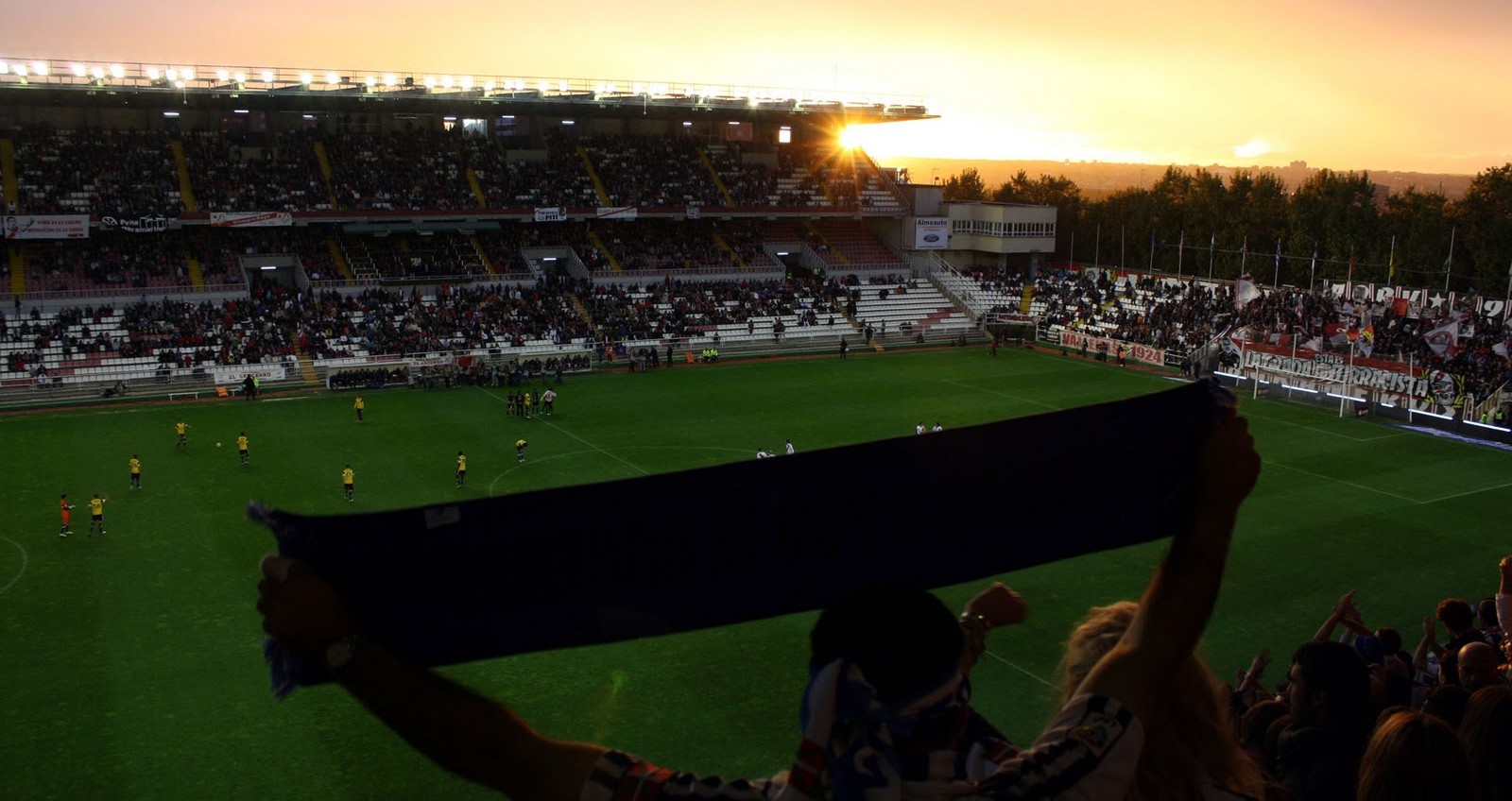
Multiple clubs in top flight football has for years been the preserve of London & Moscow. Then at the start of the 2011-12 season, Madrid muscled in on the act with not the usual two representatives, or the occasional three, but four clubs in the top tier. We have already looked at Real Madrid’s and Atlético Madrid’s magnificent stadiums, so today we are going to take a peek at the homes of their suburban neighbours, namely Rayo Vallecano and Getafe.
If you travel to the barrio of Vallecas in the south east of Madrid you will find one of Spain’s more unconventional clubs, Rayo Vallecano. Rayo, which means lightening in Spanish, was founded in 1924 and kicked around in the local leagues for the next 25 years, By 1949 they were the district’s senior team and debuted in the Tercera league as a subsidiary of Atlético Madrid. The club also adopted its distinctive red sash in 1949 after receiving shirts from Club River Plate of Argentina, who had used the club’s Campo de El Rodival for training in the lead up to a friendly with Real Madrid. El Rodival remained the club’s home ground until the mid-fifties, when it moved to Campo de Vallecas, the former home of Atlético Madrid.
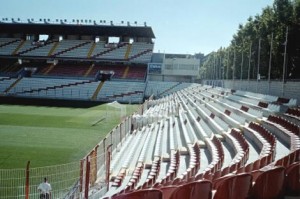 Rayo spent much of the 1960’s in La Segunda, then inOctober 1972 the club moved away from Campo de Vallecas whilst a new stadium was developed on the site. For three and a half years they played their matches at the nearby Campo de Vallehermoso. Finally on 10 May 1976, the Estadio Nuevo Vallecas opened and in the season that followed, Rayo won promotion to La Primera for the first time. Over the past thirty five years, the stadium has hosted the highs (13 seasons in La Primera, and an UEFA Cup quarter final) as well as the lows of life in Segunda B.
Rayo spent much of the 1960’s in La Segunda, then inOctober 1972 the club moved away from Campo de Vallecas whilst a new stadium was developed on the site. For three and a half years they played their matches at the nearby Campo de Vallehermoso. Finally on 10 May 1976, the Estadio Nuevo Vallecas opened and in the season that followed, Rayo won promotion to La Primera for the first time. Over the past thirty five years, the stadium has hosted the highs (13 seasons in La Primera, and an UEFA Cup quarter final) as well as the lows of life in Segunda B.
When it opened back in 1976, it had a capacity of 20,000 with the lower portions of each stand featuring terracing rather than seats. The terraces lasted until 1996, when new seats were installed throughout the stadium reducing the capacity to just fewer than 15,000. The two main stands are steeply raked and identical, except the middle tier of the southern stand features a band of red seats and the president’s box. The rest of the blocks of seats in both stands are white apart from a distinctive red sash. The popular west terrace also has this seating configuration, but behind the goal are separate entrances for the players and officials, as the changing facilities sit under this terrace. I haven’t mentioned the east end of the ground because there isn’t one, or rather so tight are the local tenements to the ground, all that stands behind that goal is a wall full of advertising. The configuration of Estadio de Vallecas is unique in top level Spanish football, which sits well with this idiosyncratic club.
Around a 20 minute drive south of Madrid is the commuter town of Getafe. A decade ago, Getafe was a town with a small club in Segunda B. That club, Getafe Club de Fútbol and its predecessor Getafe Deportivo had collectively clocked up ten years in La Segunda, many of which were played at the relatively basic Campo Municipal de Las Margaritas in the west of the town. After the municipality redeveloped the site of Las Margaritas in 1996, Getafe CF played at the Estadio de Juan de la Cierva, a municipal sports stadium around 500 yards to the west, before the impressively named Coliseum Alfonso Pérez opended for business on 30 August 1998.
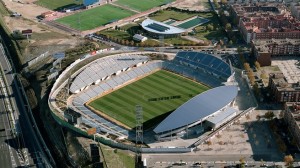 The choice of Alfonso Pérez to bear the name of its new stadium says as much about the relatively lowly standing of Getafe CF as it does about the town of Getafe’s most famous son. Although born in the town, Pérez never played for Getafe or at the stadium, gaining fame at Real Madrid and Real Betis, as well as earning 38 international caps. Whilst “Coliseum” might be stretching it a bit, the stadium was a huge improvement on the cramped Las Margaritas. It originally featured a lower tier of seating and three anfiteatros, two open on the east and north side, whilst the west side had a curious, flimsy cover that was 55 metres in length and stood high above the upper tier, offering little in the way of cover.
The choice of Alfonso Pérez to bear the name of its new stadium says as much about the relatively lowly standing of Getafe CF as it does about the town of Getafe’s most famous son. Although born in the town, Pérez never played for Getafe or at the stadium, gaining fame at Real Madrid and Real Betis, as well as earning 38 international caps. Whilst “Coliseum” might be stretching it a bit, the stadium was a huge improvement on the cramped Las Margaritas. It originally featured a lower tier of seating and three anfiteatros, two open on the east and north side, whilst the west side had a curious, flimsy cover that was 55 metres in length and stood high above the upper tier, offering little in the way of cover.
From a low of Segunda B football in 2001-02, Getafe CF rose quickly through the divisions, reaching La Primera in September 2004. During the summer of 2005, work commenced on increasing the capacity and comfort of the stadium. The southern end that had consisted of a single tier gained an anfiteatro taking the capacity to 17,000. In addition, the sheet of steel that had passed for a roof was replaced with an altogether more elegant and weather-proof cover that swept over the west side in a silver arc.
Madrid is the highest capital city in Europe and it can be a mighty cold place in winter. Its lack of shelter on three of its sides makes the Coliseum Alfonso Pérez a rather inhospitable stadium for supporters. Whether the 80 million euro investment by the Royal Emirates Group will result in a new stadium in the near future seems unlikely, but with a little imagination and not too large a budget, the Coliseum Alfonso Pérez could be turned into a smart and comfortable stadium. Who knows, they might even invest in some heaters for the hardy few that ignore the lure of the big two to brave the shows at the coliseum.
________________________________________
For more on the stadiums of Spain, visit Chris at his excellent site Estadios de Fútbol en España
Follow @icentrocampista
Related Posts
One Comment
You must be logged in to post a comment Login


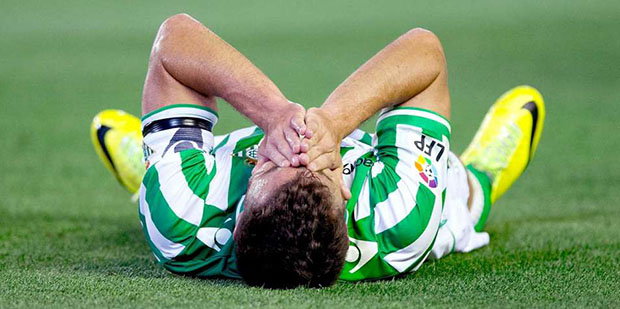
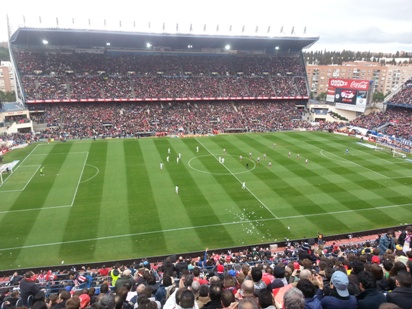



Pingback: Exploring the Stadiums of Madrid: Rayo Vallecano and Getafe – El Centrocampista « Spain Football News